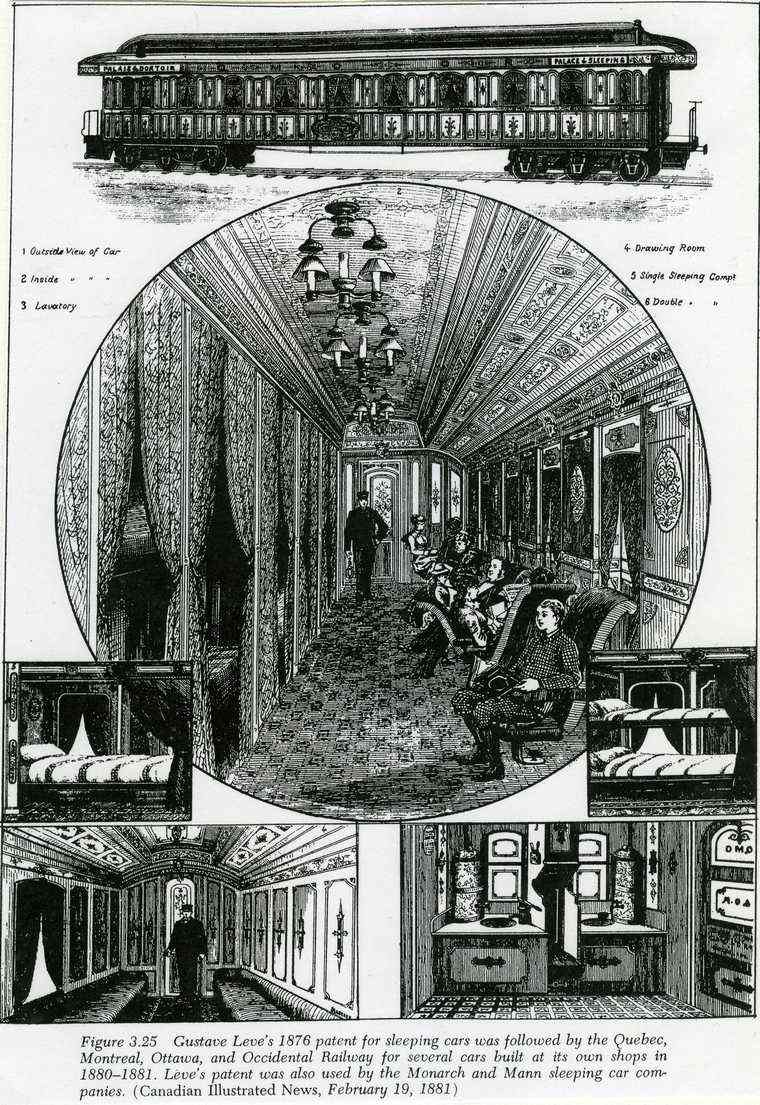|
|
|
Monarch Parlor-Sleeping Car Company.
Gustave Leve's 1876 patent for sleeping cars was followed
by the Quebec, Montreal, Ottawa and Occidental Railway (later North Shore
Railway) for several cars built, one at its own shops in 1880-81. Leve's
patent was also used by the Monarch and Mann sleeping car companies. (Canadian
Illustrated News, February 19, 1881).
The genesis of the Monarch Company appears to be a patent
(No 181,857) issued September 5, 1876, to Gustave Leve of New York. The
design's main objective was to provide a day-night car with parlor seats.
The revolving chairs were collapsible, and the bedding was stored in narrow
closets along the sides of the car. Curtains formed berth enclosures,
as in the ordinary American sleeper. The mechanism and cabinetry to accomplish
this transformation was complex and probably not worth the trouble or
expense.
Leve's design apparently lay dormant for four or five years; then in 1881
the Canadian Illustrated News described some cars of his design on the
Quebec, Montreal, Ottawa and Occidental Railway. The cars were built in
the railway's own shops, with certain improvements added by the road's
mechanical superintendent. (an engraving accompanying the article was
reproduced on page 231 The American Railroad Passenger Car).
In 1883 the Gilbert Car Works constructed two cars using Leve's patent
for export to Australia. Early in the year four more cars were in service
on the Occidental Railway of Canada and the Florida Transit. Leve had
meanwhile acquired a partner named Alden and was engaged in the excursion
business, but little information can be found on the nature of this enterprise,
Reports were circulated in July 1885 that the Monarch Parlor-Sleeping
Car Company had been formed in New York to exploit Leve's patented car.
A.F. Higgs, owner of several refrigerator lines, was to head the 5-million-dollar
organization. The cars would be named after ancient rulers, and soon sleeping
cars called ZENOBIA, CLEOPATRA, and RHODOPE were running under Monarch's
letter board. Thirteen cars were in service by the following spring. They
were 75 feet long, with 66 foot bodies, and offered 24 rotating parlor
seats by day and 12 double-berth sections by night. The 35 ton cars were
carried on eight or twelve wheels and cost $22,000 each.
In the summer of 1886 the Gilbert Car Works produced an extraordinary
parlor observation car for Monarch named YMIR. It offered service from
New York City to the White Mountains via the Connecticut River Railroad
and featured an open side isle for viewing the scenery. (In keeping with
its unusual floor plan, the car was decorated in an original scheme that
is described in chapter 4)
In addition to its Canadian, New England, and Florida contracts, Monarch
operated cars for a time between Baltimore and Pittsburg, Indianapolis
and Evansville, and Fort Smith and New Orleans. Like Mann, it had entered
the field too late; and like Mann and Woodruff, its operations were too
scattered and marginal to pay. The company appears to have struggled on
until 1893 or 1894 and was said to have built a total of thirty cars.
The details of its disposition have not been uncovered, but it does not
appear to have been taken over by Pullman. It is possible that the Gilbert
Car Company had a large interest in the concern, after the fashion of
the Wilmington shops' involvements with Mann and Woodruff. Since Gilbert
is known to have built all but one or two of Monarch's cars, Gilbert's
unexpected and complete failure in 1893 may explain Monarch's disappearance.
Reference: "The American Railroad Passenger Car pg 230,231 and 232."

|
|
